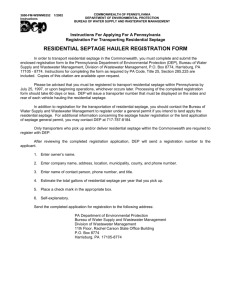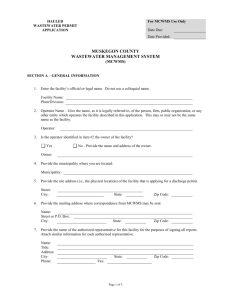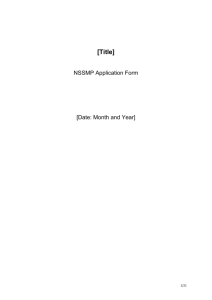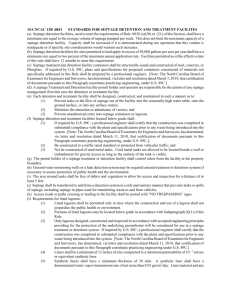WSP Study Tour to Malaysia - Agartala Municipality Corporation
advertisement
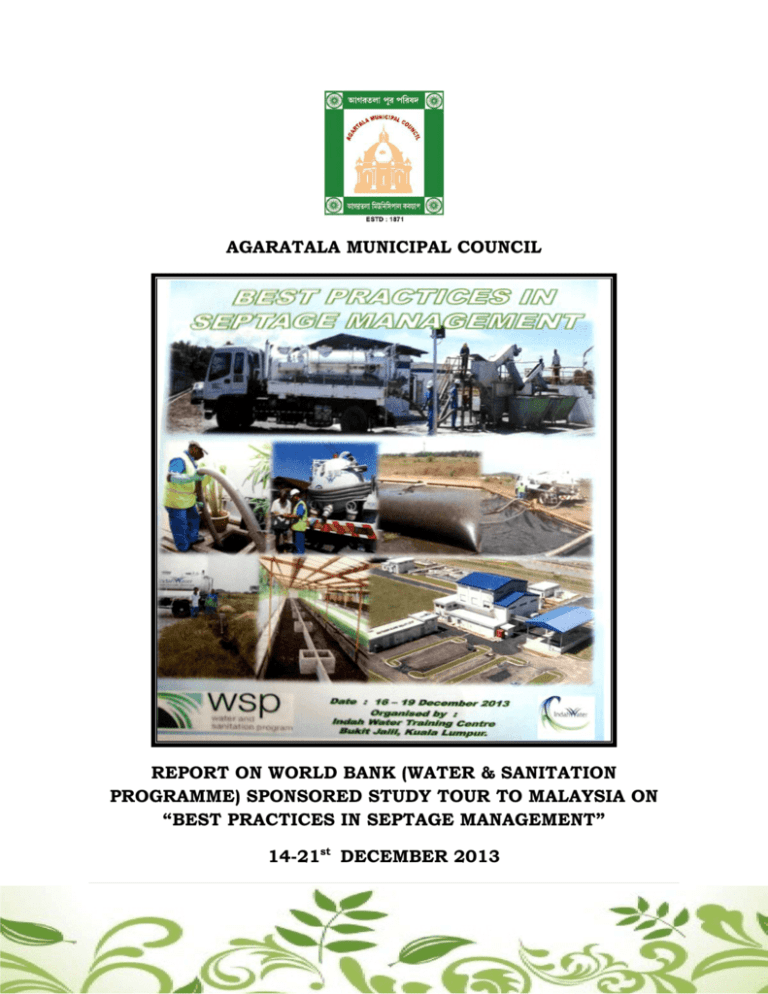
AGARATALA MUNICIPAL COUNCIL REPORT ON WORLD BANK (WATER & SANITATION PROGRAMME) SPONSORED STUDY TOUR TO MALAYSIA ON “BEST PRACTICES IN SEPTAGE MANAGEMENT” 14-21st DECEMBER 2013 1|Page Report on the International Study Tour to Malaysia organized by the World Bank Water and Sanitation Programme (WSP) on the “Best Practices in Septage Management”- 14th - 21st December 2013” Definition of Septage: Septage is the liquid and solid material that is pumped from a septic tank, cess-pool, or other treatment facility after it has accumulated over a period of time. The Septage has an offensive odour and appearance and is a host for many disease causing organisms and is major cause of pollution of water bodies and environment. India’s National Urban Sanitation Policy (NUSP) defines sanitation as “safe management of human excreta, including its safe confinement, treatment and disposal and associated hygiene-related practices.” NUSP has accorded high importance to plan and implement actions for the organized and safe management of fecal matter from on-site installations that hitherto have received limited attention. Proper construction, maintenance management and safe disposal of septage from septic tanks and pit latrines have received very limited attention in India. In the context of Tripura, approximately 42 % of urban households rely on septic tank systems and partial sewer network is under construction only in Agartala. In case of Agartala around 60 % -65% households have septic tanks. Under JNNURM only 11000 household out of 90000 houses are going to be connected to the sewer pipe line under JNNURM Sewerage scheme in North Zone of Agartala Municipal Council. Therefore it makes a very compelling case to promote septage management as a cost effective and sustainable treatment option. Brief Information about the sanitation status of Malaysia: In order to achieve 100% sanitation in urban as well as rural Malaysia by 2020, the Federal Government of Malaysia amended the Constitution of Malaysia and brought the Sanitation on concurrent list from that of the State List. 12 out of 14 States in Malaysia accepted this proposal by the Federal Government. Before 1994 Sanitation was on the State List of the Constitution of Malaysia and the State Government/local bodies were unable to provide total sanitation to the citizens. After this amendment the Federal Government awarded the work of Septage/sewerage management to one Private Company named Indah Water Konsortium( IWK) in 1994 which is being highly subsidized by the Federal Government of Malaysia. Septage/Sewerage treatment facilities are being constructed by the Government and are being operated and maintained by IWK. IWK imposes minimum tarrif from customers for various services such as provision of Suction Tanker ( Cess-Pool) services. The IWK manages total 5960 Septage/Sewerage Treatment Plants(STP) across 12 States out of 14 2|Page states of Malaysia starting from very primitive technique such as Trenching System, Sluge Drying Beds, Geobags etc to most modern Sewage Treatment Plants(Reactors). Sewerage infrastructure status of Malaysia: In Malaysia all the big cities such as Kuala Lumpur, Putrajaya, Port Dickson etc are having underground sewage pipeline system. But small towns, rural areas and even some nearby sub urban areas to Kuala Lumpur are not having underground sewage pipeline system and it is becoming more and more difficult for Malaysian Government to construct under ground Sewage Pipeline everywhere due to various reasons one of which is huge financial cost for laying of underground sewage pipeline. But where there is no Sewage line, household septic tanks are mandatory. IWK collects Septage( Sludge from Septic Tanks)by using various sizes of Suction Tankers( Cess-pools) following all the standards operating procedures and transports this Septage to nearby septage/sewerage treatment plant for treatment and generation of dry manure which is generally used for landfilling, manure for non food crops such as rubber, floriculture, gardening etc. Collection of Septage Transportation to treatment site Use of manure for non food crops 3|Page Development of Manure Treatment of Septage( Drybed) Generation of sludge from septage Septage Treatment Technology which are being used in Malaysia: 1. Non Mechanized: Trenching System, Drying beds( open/covered), Geobags etc 2. Semi Mechanized: Belt press, mobile dewatering, centrifuge decanter 3. Mechanized: Centralized Sludge/Sewerage Treatment Facility 4|Page • World Bank (WSP) Programme at Kuala Lumpur, Malaysia- The International Study Tour to Malaysia on the ‘Best Practices in Septage Management’ was arranged by the World Bank-Water and Sanitation Programme(WSP) from 14th December 2013 to 21st December 2013 consisting of 25 Delegates consisting of 19 from India, five from Bangladesh and one from Pakistan. Indian Delegation- Four from Tripura including hon’ble Chairperson AMC, CEO AMC, JE Kamalpur NP and JE Bishalgarh NP, Four from Kerala, Four from Madhya Pradesh, Five from Government of India, Two from World Bank Office New Delhi. Training and workshops of the team of delegates was organized at the Training Center of Indah Water Konsortium (IWK) at Bukit Jalil Kuala Lumpur. Presentations were given by Sri Ir Zakaria Md Yassin-Overview of Septage Management in Malaysia, Regulating Local Development and Septage Management. Financial Management of Septage Management by Mr. Lim Choon Line, Selecting appropriate Technology for Septage Treatment by Taukif Saleh, Sizing Collection and Treatment Infrastructure by Mr Wee Soon Guan, Management Information System by Mr Wee Soon Guan and Information & Education campaign for Septage Management by Mr Shahrul Nizam b. Sulaiman. Also the delegation visited Administrative Capital of Malaysia i.e. Putrajaya and interacted with National Water Service Commission( SPAN) of Government of Malaysia and Dy Director General Department of Environment, Government of Malaysia. Site visits were given to various Septage Treatment Facilities being operated by IWK such as Mechanized Dewatering Unit(MDU) and Trenching System( Sludge Drying Beds), Geobag Sludge Facility, Centralised Sludge Treatment facility in and around Kuala Lumpur. Also the delegation watched actual de-sludging work in one suburb of Kuala Lumpur using Suction Tanker(Cess-Pool). 5|Page Inference /Observation from the visit: It is evident that Government of Malaysia gives foremost priority to Sanitation and has almost achieved 90-95 % target and has planned to achieve 100 % sanitation by the year 2020. Instead of adopting very costly approach everywhere, Malaysia has adopted practical scientific technologies for Septage/sewerage treatment suitable to the locality and financial implications. As Malaysia uses almost 100% surface water for drinking purpose, the countrywide scientific septage Management Programme has significantly helped Malaysia to eliminate various water born diseases such as Typhoid, Jaundice, Cholera, Diarrhea, Dysentery etc. indirectly saving huge revenue which would have been spent on the treatment of these diseases. Strategy Adopted by Indah Water Kansortium (IWK), Malaysia for Septage/Sewerage Management: 1. Regular clearing of Septic Tanks on rotational basis once in two years using Standard Operating Procedures, transportation and treatment in some sort of Septage/Sewerage Treatment plants. 2. Charge of RM( Ringgit) 6-8 i.e. INR120-160 per month per household for Septage/Sewerage Management i.e. Rs(INR)1440-1920/year per family. 3. The Septage/sewerage management is not profit making business, hence has to be subsidized by the Government significantly by the Government. 4. IWK relies more on persuasion and IEC activities rather than legal remedies for compliance from the citizens. 5. IWK uses many modern means of Information Technology such as E Mails, SMS, Television adds etc for information to the Citizens. 6|Page 6. Soft database of all households and the type of septic tank along with other details such as location addresses has been created by IWK and MIS is automatically generated by the software systems so as to manage visits to households for regular clearance of septic tanks and also to monitor tax compliance. 7. The sludge generated from Septage treatment is used for various purposes as Manure for non food crops such as Rubber, floriculture, land filling, eco-brick making etc. 8. Quality checks of underground water, modern laboratory facilities for various testing in connection with the scientific septage management 9. Periodic trainings/workshops, capacity building programmes for this purpose. Applicability of Scientific Septage/Sewerage Management in Tripura on the patterns of Malaysia: Like that of towns and Rural areas of Malaysia, various towns of Tripura including Agartala do not have systematic underground sewerage network pipeline. As laying of under ground sewage pipeline is very costly, it may not be possible for the State Government to construct under ground sewage pipeline networks in all the towns of Tripura. Most of the houses are having some sort of septic tanks which are generally manually cleaned after it gets full and the septage is flown unscientifically into the storm water drains thus contaminating water bodies and underground water as the underground water table at many places in Tripura is very high. Even in Agartala which is the capital of Tripura there is no underground sewerage system. Only in North zone of Agartala Municipal Council Under Ground Sewerage System along with state of art 8 Million Litre Per Day(MLD) Sewerage Treatment Plant is being implemented for only 11000 household out of more than 90000 household in Agartala City which will be operational by March 2014. In the first phase only 5000-6000 hoses will be connected to the underground sewerage line. In other three zones of the city there are mostly septic tanks in each home and some unscientific pour flush/pit latrines in around 20000 households which are mostly poor for which ILCS scheme is being planned. This means more than 60000 houses are relying upon some type of septic tanks which are mostly manually cleaned as Agartala Municipal Council does not have capacity to mechanically clean all the septic tanks at 7|Page present due to shortage of Suction Tankers(cess-pools). The septage which is manually cleaned is flown directly into the storm water drain leading to massive contamination of water bodies including the river Haorah which is source of drinking water also. As the underground water table at many places in Agartala is very high, there are high chances that the underground water might have been contaminated due to seepage of septage. Due to this reason the drains are full with black coloured septage and also water from various water bodies in the city looks blackish instead of bluish. This also leads to international problems as the Akhaura Khal of Agartala carries this septage across international border to Bangladesh for which Bangladesh has raised objections several times. Present condition in Agartala City and Plan for Scientific Septage/Sewerage Management and Sanitation in Agartala CityDemographic and sanitation related information of Agartala City • • • • • • Population: 398000(2011 Census) Total number of families as per the Register of Ordinary Residence under AMC: 114000 Household No across Agartala City-90000 Septic tank Number- 60000(tentative) Dry Latrines/Un-Sanitary latrines- 30000 Daily generation of septage (Human Excreta)-125000-150000 kg As there is no extensive sewerage system and there are relatively large number of kaccha/dry latrines along with the practice of putting the overflow of septic tanks directly into the storm water drainage, leads to pollution of waterbodies of the city including the main river Haora. Extent of Pollution of Water bodies under Agartala City: The Central Pollution Control Board has identified the river stretch along the City of Agartala for the Haora River to be one of the grossly polluted stretches in minor river basins in India and has recommended immediate conservation measures The Tripura State Pollution Board carried out assessments and recommended implementation of a comprehensive sewerage collection and sewage treatment system for the City of Agartala. Pollution data of only main river i.e. Haora river is available as there have been scientific studies by the Tripura State Pollution Control Board in this regard. Regarding other water 8|Page bodies there is no any systematic study but it may be presumed that most of the water bodies under Agartala city are polluted as there is no any scientific sewerage system under the city. Main reasons of Pollution of Haora River and other Water bodies of Agartala City: As there are no major industries in Agartala City, main cause of pollution of water bodies including Haora river is the contamination of human waste (septage) with the water bodies. Water-bodies get contaminated with the human waste in following manner. 1. Practice of manual cleaning of septic tanks: Practice of manual cleaning of septic tanks and throwing of the septage thus collected into the storm water drainage which ultimately flows to Haora and other water bodies of the city. 2. Direct connection of overflow pipes of septic tanks into storm water drain: In most of the households there is no soak pit attached to the septic tank for soaking the overflow of septic tank. The overflow is directly put into the storm water drainage which ultimately flows to Haora and other water bodies of the city. As per the Tripura Building Rule 2004 soak pit is mandatory for all the septic tanks. 3. Relatively large number of kaccha ( pit latrine/pour flush latrine) latrines: There are about 20000 kaccha latrines in the city. Most of these latrines are directly connected with the storm water drainage or some water channels or river. As per the report of the Tripura state Pollution Control Board 1145 Kaccha latrines on the bank of Haora river have direct connection into the Haora river. As per the report of the Tripura State Pollution Control Board, pollution indicators of Haora river in Agartala City are given as follows. SN Parameters 1 2 Standard Value Temperature Total Dissolved solids( 500 mg/l) 9|Page Locations Point origin Haora River 28.5 156 of Near Near of Chandrapur Bangladesh Agartala border 30.0 174 30.5 220 3 4 5 6 7 8 9 10 11 12 13 14 15 16 17 18 19 Total suspended solids(mg/l) pH Colour (l/m) Turbidity(NTU) Alkalinity DO(Mg/l)(Dissolved Oxygen) BOD(mg/l)( Biochemical Oxygen Demand) COD(Mg/l)(Chemical Oxygen Demand) Total Coli form(MPN/100 ml) Phosphates(mg/l) Hardness(Mg/l) Calcium(Mg/l) Magnesium(Mg/l) Chloride(Mg/l) Nitrate(Mg/l) Nitrite(Mg/l) Ammonical Nitrogen(mg/l) 10 | P a g e - 26 46 180 6.5-8.5 10 6 7.65 2.5 5 69.34 7.2 7.34 10.2 26 120.20 6.24 8.10 12.6 38 143.02 5.6 3 1.9 3.5 8.6 6 8 22 39 500 110 540 1800 300 80.10 24.28 250 20 1.2 0.010 59.55 15.91 4.8 7.2 0.02 0.01 nil 0.020 84.36 23.86 6.02 9.6 0.025 0.035 0.016 0.065 178.65 35.79 21.63 24 0.060 0.040 0.025 Abovementioned figures indicate that Haora river becomes grossly polluted in Agartala City before it crosses the international border into Bangladesh. 11 | P a g e Septage Management under AMC at Present: Manual & Mechanical Manual: As there are 65000-70000 septic tanks in Agartala and one septic tank gets full and requires cleaning within on an average 6-8 years. This means each year more than 8000 septic tanks are being cleaned in Agartala City out of which AMC got only 940 orders last year and remaining have been cleared manually. Thus manual cleaning of septic tanks is in vogue and septage thus cleared, is flown into storm water drainage. Due to this reason main Channel of City i.e. Akhaura Khal is full of black coloured Septage with offensive odour which is directly flowing to Bangladesh across international border at present without any treatment. Akhaura Khal ( Channel) near International Border Mechanical: : Agartala Municipal council is practicing mechanical septage collection by cess-pool since past few years. AMC has two no of cess-pool ( Suction Pumps) machines at present. Daily about 7-8 septic tanks are cleaned using two number cesspool. Disposal at present is un-scientific. Septage is dumped in the landfill untreated. In 2012-13 AMC could cater only 940 orders for mechanical septage clearance and collected fees of Rs. 852766 @ rate of Rs. 900/trip. As there is shortage of cess-pools, AMC is not able to clean more septic tanks at present. Septic tanks being cleaned by cess-pool machines under ward no 2 of AMC 12 | P a g e Difficulties and problems faced by AMC in the field of Scientific Septage management: • Only two functioning cess pools which can cater only 6-8 orders per day Lack of ability of AMC to cater entire orders and pendency problem • No access too narrow lanes and gullies as the cess pool can not enter narrow lanes and small roads at present • High expenditure per trip of cess pool and subsidized rate • No scientific disposal of septage/sewage at present • No any compulsory practice of construction of soak pit along with septic tank, overflow pipe of septic tank is put into storm water drainage leading to pollution of water bodies of city and international water. • There are large number of unscientific/dry/kaccha latrines in city. As per the Tripura Pollution Control Board Survey in 2010-11there are more than 1145 latrines along the Haora river have direct connection into the river • No any proper database of septic tanks • No any calendar for regular and rotational cleaning of Septic Tanks using Cess-pools by AMC • Migration of families to the city from other areas of Tripura and rapid expansion of the city • Less awareness among the citizens regarding Septage Management as the concept is relatively new for Tripura • Slow speed of implementation of Sewage Scheme (JNNURM) under North Zone of AMC due to various reasons 13 | P a g e Action Plan of Agartala Municipal Council for Scientific Septage/Sewage Management: 1. Sewerage/Sewage Scheme Under North Zone: Agartala Municipal council has taken up Rs 102.21 Crore Scheme under progress JNNURM for North Zone of Agartala Municipal Council –to be operational by March 2014. Almost 80 % work completed. The scheme may be operational by the end of current financial year The components are1. Sewerage House Connections and pipelines-11000 sewerage connections, 95 km and 3500 manholes 2. Sewage Pumping Stations- 9 no. 3. Sewage Treatment and Disposal Facilities-8 MLD capacity 2. Plan for Mechanical scientific treatment: Mechanical collection of septage 14 | P a g e Septage Collection, Transportation Proposed treatment of septage in STP by March 2013 and Following steps are being taken up by Agartala Municipal Council so as top statrt Scientific Septage Management in Agartala City by March 2013. i. AMC has set up the target to clean 6000-7000 septic tanks mechanically per year using Suction Tankers(cess-pool) machines. Presently AMC could get only 950 cess pool orders last year. ii. Procurement of New four numbers Cess Pools( Suction tankers) including split type cess pools designed by the Mechanical Wing of AMC to get access in narrow lanes by March 2014. Supply Order has already been placed. iii. House to House Survey of septic Tanks iv. Preparation of soft database of septic tank information v. Restructuring of tariff structure for cess pool services so as to make entire process including the operation and maintenance of proposed STP sustainable. vi. Elimination of manual clearing/cleaning of septic tanks under Agartala City vii. Proper duty assignment to the Septage Management Staff viii. Protective Measures for SWM Staff including Medical Dispensary for SWM staff ix. Development of MIS System x. Plan for regular clearance of Septic Tanks once in five years on rotational basis xi. Provision of cess-pool services to the nearby areas surrounding Agartala city xii. Development of software programme with the help of NIC or DIT for online booking and payment of Cess pool services by the citizens, scope for citizen grievance redressal in this sector xiii. Public Awareness by Print/electronic media- development of small video clips, school awareness programmes, printing attractive leaflets, radio programmes, publicity on posters, placards, rallies, 15 | P a g e bus stops, sulabhs etc, citizen programmes and seminars. Plan for organization of site visits for students, citizens, media, Periodic press notes etc xiv. Plan treatment of Septage in 8 Million Liter Per Day( MLD)Sewerage Treatment Plant which is going to be operational by March 2014. xv. Misc: Filling of the post of Special Officer SWM( Preferably an Environmental Engineer), Development of Standard Operating Procedures(SOPs) for Septage management under Agartala Municipal Council, Implementation of other related measures: Integrated Low Cost sanitation (ILCS) Scheme implementation under AMC: Integrated Low Cost sanitation is scheme for urban poor under Ministry of HUPA, Government of India. Already a DPR for construction of 18790 ILCS units across the city of Agartala has been approved by the Government of India in 2012 and till date more than 3500 ILCS units have already been constructed under this scheme. Agartala Municipal council is trying hard to complete the target of construction of 18970 no of Integrated Low Cost Sanitary Latrines by the end of March 2014, which will help to eliminate the practice of dry latrines and open air defecation from Agartala City and shall help significantly to reduce the contamination level of the rivers and water bodies. Old Dry Latrine New ILCS Latrine 16 | P a g e Regular use of De-Silting Machines for cleaning of various drains under Agartala city: Two number of powerful de-silting machines have been recently procured by AMC recently which will be helpful for reduction of manual cleaning of city drains to significant level. The silt is being disposed in the landfill at the Dump yard and subsequently will be treated in the 8 MLD Sewerage Treatment Plant which will be functional under North Zone of Agartala Municipal council by March 2014 under the JnNURM sewerage Scheme. These machines will ensure speedy cleaning of covered drains of city. Newly Procured De‐ Silting Machine Dump Tank of De‐Silting Machine By implementing all the above mentioned programmes and schemes, Agartala Municipal Council is hopeful that pollution level of all the water bodies of Agartala including the Haora river will reduce to significant extent within the coming one to two years. What can be done for other towns of Tripura for Scientific Septage Management on the lines of Malaysia: It is proposed that following steps may be taken up by the Department of Urban Development Government of Tripura for implementation of Septage Management Programme in all the towns of Tripura. 1. Procurement of Two Suction Tankers ( Cess-pools) for each Nagar Panchayat/Municipal Council other than Agartala: For implementation of scientific Septage Management there is an urgent need of Suction Tankers( Cess-pools) for all the other towns than Agartala. Agartala Municipal Council may procure cesspools by transparent tender 17 | P a g e process on the behalf of all the Municipal Councils and Nagar Panchayats if the fund is made available. Already AMC is in the process to procure one cess pool for Udaipur Nagar Panchayat. Repair and maintenance of all these cess pools can be done in the work shop of Agartala Municipal council at Barjala. Fund required for each Nagar Panchayats/Municipal Council for this will be Rs. 4000000/( Rs Forty Lakh only) i.e. Rs. 20 Lakh for one Cess Pool 2. Treatment of Collected Septage: Development of covered dry beds for treatment of septage thus collected from septic tanks. At present most practical way of septage treatment in the town of Tripura other than Agartala will be using dry bed technology for sludge treatment as it is most economical. Later on Government may construct Semi Mechanized Septage Treatment Plants as per the availability of fund. Covered Dry Bed Method Trench Method( where water table is deep) The requirement is construction of 6-8 RCC dry beds with covered transparent roofs so as to develop dry sludge from semisolid septage by way of evaporation on rotational basis. Requirement is land about ½ acre with vehicular access and construction of drybeds. Some sort of Khas land may be used for this purpose or land may be requisitioned under Forest Right Act if possible. The drawing and designs may be given by the experts of World Bank of Engineers of Agartala Municipal Council. Fund requirement. Fund requirement may be Rs. 6000000/-( Rs Sixty Lakhs Only) i.e. Rs Ten Lakh for each dry bed. Even as that of some Rural areas of Malaysia, simple Trench Method can also be applied for Septage Treatment and disposal initially. In this method kaccha trenches are constructed on the land with some higher elevation where the underground water table is relatively deeper so that contamination of 18 | P a g e ground water may not take place. The water from septage gets absorbed in the subsoil and the sludge is assimilated with the soil. In this case some periodic ground water testing facilities are needed which may be provided from Agartala. 19 | P a g e 3. Procurement of one skid steer loader one for all the Municipal Councils and Nagar Panchayats for mechanical clearing of dried sludge. Fund requirement for this will be Rs. 20 lakh for one NP. Total Fund requirement for each Municipal council/ Nagar Panchayat for implementation of Scientific Septage Management: 1. Procurement of two Cess-pools( Suction tankers)Rs. 40 Laks 2. Procurement of one Skid Steer LoaderRs. 20 Lakhs 3. Construction of 6 no. Sludge Dry Beds with RCC base- Rs. 60 lakhs ……………………………………………………………………………………………. Total fund required (Tentative) for each Municipal council/ Nagar PanchayatRs. 12000000/(Rs One Crore Twenty Lakhs) Along with this various other measures which needs to be taken up for scientific septage Management at Municipal council/ Nagar Panchayat are: 1. Proper IEC activities in the field of septage management for public awareness and public support. 2. Proper tariff restructuring for cess-pool services so as to make this entire project starting from Mechanical Septage collection to treatment at dry beds and collection of dry sludge mechanically from dry beds etc sustainable. 3. Proper enforcement of Tripura Building Rules 2004 and inclusion of septic tanks while giving approval for any building plans. 4. Measures may be taken to eliminate the practice of manual clearing of septic tanks. 5. Proper implementation of ILCS scheme 6. Public awareness, community participation By (Milind Ramteke, IAS) Chief Executive Officer Agartala Municipal Council 20 | P a g e Summary: During the visit of delegation for study of “Best Septage Management Practices in Malaysia” sponsored by the World Bank( WSP), it was evident that Malaysia was facing the same problem of low sanitation coverage before 20 years like that India and other developing countries are facing in their cities, towns and rural areas. In India, State Governments/Local Bodies are planning or constructing underground Sewage Pipeline in Metro Cities, but this may not be possible in each and every city and town of the country due to paucity of funding. Families in most of the middle level cities and towns of India rely over the individual septic tanks in their houses for septage collection. As there are various programmes by the GoI and various State Governments to construct individual toiles and public toilets in semi urban and rural areas of country, open air defecation and practice of dry/unscientific latrines may get eliminated in due course of time. But till date there has been no any project in the country regarding scientific management of septage and sludge from the septic tanks. At present this sludge/septage is thrown/flown into the drainage or at open places leading to pollution of surrounding environment. Lessons can be learnt from successful septage management programme being implemented by Malaysia for collection, transport and proper treatment of septage in semi urban and rural areas so as to prevent the pollution of environment. By following simple, low cost to most modern scientific practices for treatment of septage/sewage, Malaysia has achieved almost 95% sanitation by this time and aims to provide 100% sanitation to its citizens by 2020. On the lines of Malaysia, Scientific Septage Management Project can easily be implemented in cities and towns of Tripura with some initial investment by the State Government. In future we can take this programme to rural areas also like that of Malaysia. Already Agartala Municipal Council is operating two number of Cess-Pools( Suction Tankers) for septage collection from Septic tanks in Agartala city and people of Agartala know this concept and have willingness to pay for the Cess-pool services. AMC may start full fledged Septage Management Project by March 2014 when the 8 MLD Sewage Treatment Plant(STP) will be operational for scientific treatment of Septage and new four no of Suction Tankers( Cess-pools) will be procured before March 2014 for increasing collection efficiency. Sanitation nowadays is one of the foremost priority of all the state Governments and Urban Local Bodies. The project of Septage Management may require little investment by the State Government or Local Bodies but it can save huge public money by reducing expenditure for treatment of various water born diseases and raise life standard of common people a lot. ****************************** 21 | P a g e

